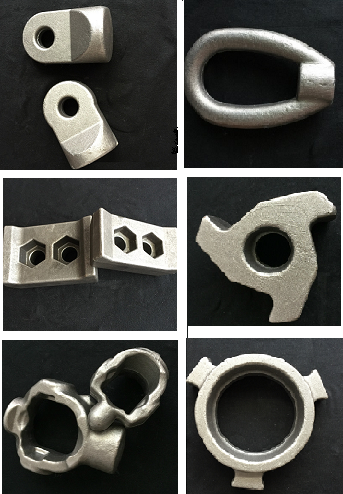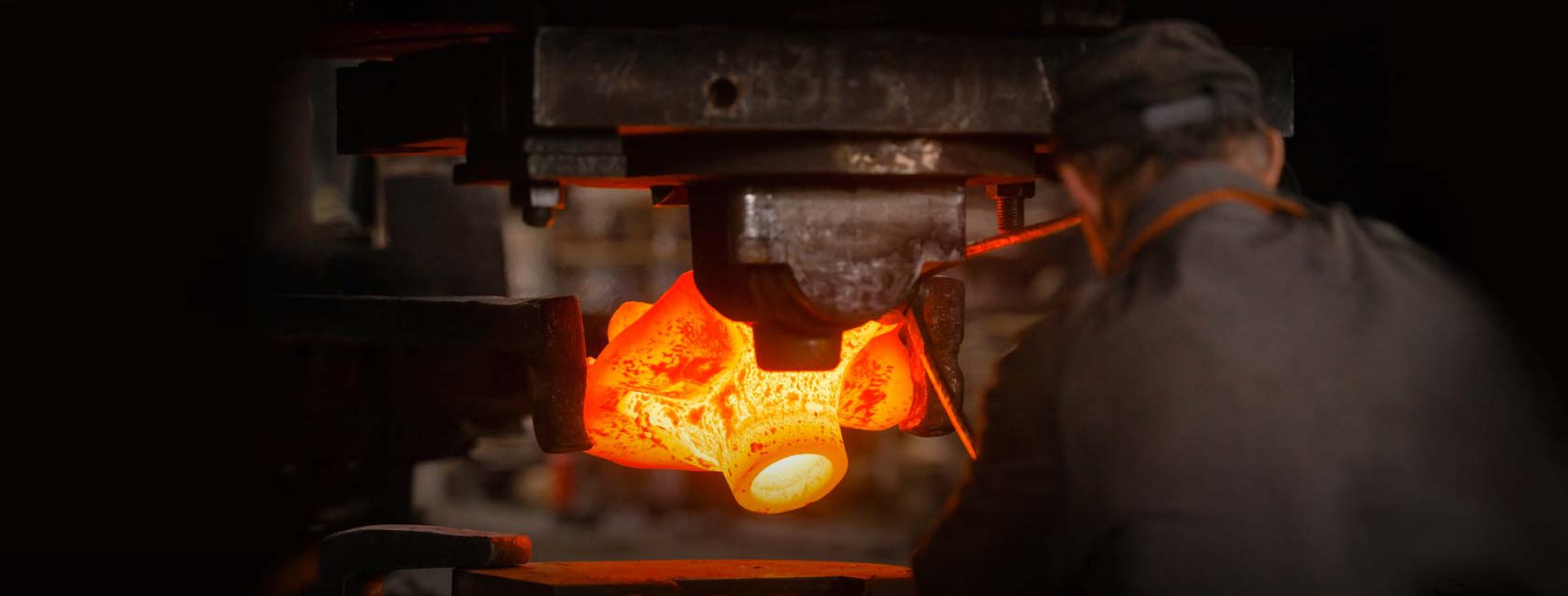What is Closed Die Forging?
Closed die forging, also known as impression die forging, is one of the forging types for small or medium metal components. Close die forging is a plastic deformation process where, unlike in the open die forging process, the material is forced to flow in a closed shape called die. Compared to the open die forging, the close die forging (said also hot drop forging) can achieve more complex geometries, very much close to the dimensions of the finished component. The plastic deformation is given rapidly through some shots which force the material to fill the shape of the die. The process is performed at the plastic temperature of the material in use without intermediate re-heatings.
A key step in closed die forging is the design and the production of the dies, process which is part of the know-how of the manufacturer. Most common used forging dies material are tool steels. For the high material cost and machining cost, cost of forging dies are always much higher, but it is one time cost, will not be charged from our customers for next batch production. Unlike the open die forging, suitable to manufacture also individual parts, the close die forging is used to manufacture series production as this is particularly convenient to absorb the costs the dies. The close die forged product shows several advantages like the typical flow lines of the material along the profile of the component, beneficial particularly on mechanical components put in service under cyclic fatigue. This process allows furthermore to use reduced over-dimensions, feature which allows cost savings on input weights as well as on final machining due to less material to remove. The close die forging process is typically used for critical components, in our case on railway, petrochemical, electrical, lifting and safety system, industrial and agricultural machinery sectors.
Closed Die Forging Process
Closed die forging is the process that metal is placed in a die resembling a mold attached to an anvil. Usually the hammer die is shaped as well. The hammer is then dropped on the workpiece causing the metal to flow and fill the die cavities. The hammer makes contact repeatedly within milliseconds. Depending on the size and complexity of the part the hammer may drop multiple times in a series of quick successions. The excess metal that is squeezed out of the die cavities is referred to as flashing. The flash cools more rapidly than the rest of the material and the flash is usually stronger than the metal in the die so it helps prevent more flash from forming. The flash also forces the metal to completely fill the die cavity and after forging the flash is removed.
In commercial closed die forging, the workpiece is usually moved through a series of cavities in a die to get from ingot form to the final form. The first impression is used to distribute the metal into the rough shape in accordance to the material needed later in the cavities. This impression is called an edging or fullering or bending impression. The cavities after this are called blocking cavities in which the piece is worked into a shape that more closely looks like the final product. These different stages usually give the workpiece generous bends and large fillets. The final shape is forged in a finisher or final cavity. If there is only a short run of the parts then it may be more economical to forgo the final impression cavity and instead machine the part.
Common Materials in Closed Die Forging
While closed die forging is applied for almost all the metal materials, in actual production, only part of the materials are used for the different characteristics. The material used is one of the main factors that affect the cost of the forgings. Let’s take a look at some of the common materials used in closed die forgings.
Steel
When it comes to closed die forging, steel is by far the most common material used. Alloy steel, carbon steel, and stainless steel are all used depending on what the forging is used for. Stainless steel material is often used for components that require corrosion resistance and rust resistance. Alloy steel and carbon steel are the most widely used in closed die forging process for its competitive price and easy deformation.
Aluminum
Aluminum is popular due to its low density, high strength, and easy machining. It is widely used in closed die forging process especially for the automotive and aerospace industries. Although it is commonly used in the aerospace and automotive industries, it is a challenge for domestic forging due to the fact that it is easily deformed after forging.But heat treatment can help to improve the hardness and other properties.
Copper or Brass
Copper or brass is also commonly used in closed die forging, which is the most expensive of the three materials that we have discussed. Copper forging or brass forging is most commonly used for valve and pump fittings.
Benefits of Closed Die Forging
- Distinct from investment casting, initial costs of forging dies for developing a metal components in closed die forging is quite high, but by comparison, if the parts are in high volume, it is the most cost-effective metal forming methods for the low cost of each part.
- During closed die forging process, the pressing of workpiece between forging dies will refine the inner grain, and the mechanical properties of closed die forged parts, especially the strength, will be improved. So, when safety factor and strength is considered, like lifting & rigging hardware, closed die forging will be the unique choice.
- As products are deformed in high precision forging dies, so the toleraces of closed die forging parts are always tight. And surface finish is always good. Normally, we can control closed die forging parts within tolerance +/- 0.5mm. In this way,this forging technic is a net or near net shape process that requires less or no machining. So for same parts made in forging and casting, there will be aobvious advantages of closed die forging for its less machining cost.
- Material is saved. If you learn about closed die forging, then you will know the only waste of material during forging process is the flash. Such flash will be moved by trimming die, and you will be a finished forging blank after that. Thus we can see the flash is the only redundant material, but it can be recycled.
- Closed die forging service in China can offer more price advantage as well as other advantages.
Materials of closed die forging are not limited, it can be steel, aluminum, brass, etc. Although there are lots of benefits in closed die forging, it does not mean it can be used to make all the metal components, for thin and complex shaped components, it is not feasible. So each metal forming process has its own limitations.
How Closed Die Forging Compared to Other Methods?
Sometimes, there are many ways to manufacture a item, and we need to evaluate each one before ordering. Below we will show how closed die forging compared to open die forging, investment casting, and machining.
Closed Die Forging vs Open Die Forging
In open die forging a cylindrical billet is subjected to upsetting between a pair of flat dies or platens. Under frictionless homogeneous deformation, the height of the cylinder is reduced and its diameter is increased. Forging of shafts, disks, rings etc are performed using open die forging technique. Square cast ingots are converted into round shape by this process.
Closed die forging is a precision forging process for its precise tooling or dies, while open die forging is free forging with simple tooling. So closed die forging can provide much more precision components, specially for small and medium parts. And open die forging is only for large products.
Closed Die Forging vs Investment Casting
Different from closed die forging, investment casting is the casting method by pouring liquid metal into molds to form the shapes. The same point of these two methods is that both of investment casting and closed die forging can manufacture components in accurate dimensions and tolerances. But defects may be easily produced by investment casting, which could be effectively avoided in closed die forging.
Another advantage of closed die forging is that, the pressing operation of billets will greatly increase the strength of products. So closed die forging is especially suitable for components in safety consideration, such as lifting & rigging hardwares.
Closed Die Forging vs Machining
For simple shaped parts, machining from bars directly is also the option for desired dimensions. Compared with closed die forging, there will exsit large amounts waste of raw material. Also, the properties and working performance of closed die forged components will be much better than machined ones.
Closed Die Forging Application
Closed die forging is mainly used for the production of steel and aluminum components. So the application of closed die forging is wide. It coud be used for the production of mining drilling bits, forestry wear parts, agricultural wear parts, construction wear parts, rigging and lifting components, etc. In a word, Any application requires high quality components could adopt this type of method.
 Closed Die Forging Company
Closed Die Forging Company
CFS Forge is a global supplier in China for closed-die forgings, focused on various markets such as oil & gas, construction, mining equipment, power generation and military applications.
With its strong and well-known technical expertise, CFS forging plant jointly designs with customers and supplies close die forgings of various shapes up to 50kg. Specialized in small to mid-size production runs, Our company has the capability to forge a wide range of steel grades, from carbon steel to stainless steel. Our investment in machining and control also enable us to supply customers rough or finished machined components, ready to assemble.
We can provide:
• Steel forgings up to 50kg
• In-house heat treatment
• In-house forging dies and tooling manufacturing
• Rough and finish machining
• Cost optimization studies
• Digital forging simulation
• Quick-turnaround cost estimation
So, CFS Forge is your one stop source for forged products. Any steel forging projects in closed die forging method, pls do not hesitate to contact us. You will enjoy both price and quality advantages from our company.


